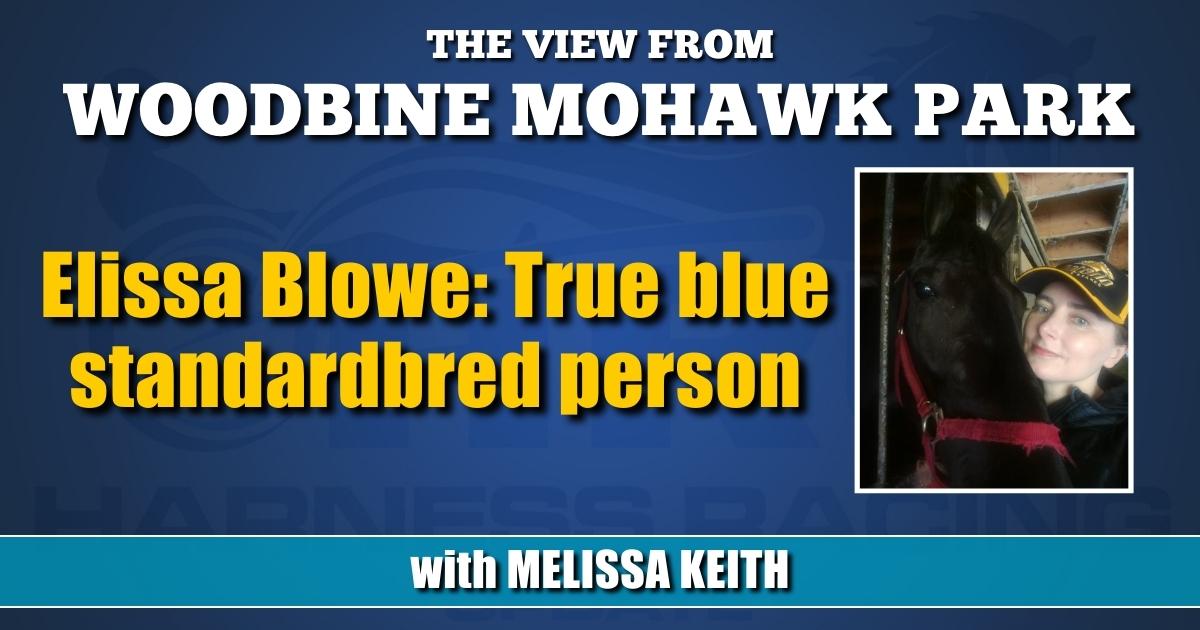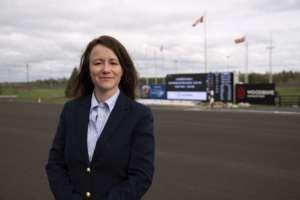Elissa Blowe: True blue standardbred person
Woodbine Mohawk Park simulcast show welcomes a familiar face.
by Melissa Keith
The Woodbine Mohawk Park (WMP) 2023 International Women’s Day simulcast was a harbinger of good things to come, especially for one woman with deep roots in Ontario harness racing. On March 9, Elissa Blowe co-hosted the special show alongside regular WMP racing analyst/commentator Monique Vág.
On April 17, Blowe returned to the desk alongside Canadian Horse Racing Hall of Fame driver Randy Waples, who officially became a regular WMP racing analyst on Dec. 12, 2022. They were joined by WMP newcomer John Rallis, who began the show reporting from the Mohawk paddock.
Blowe is a horsewoman who has been involved in harness racing since childhood, when her parents drove (dad Don Blowe) and trained (mom Beth Blowe). The family had a small farm with a quarter-mile training track.
“My dad had a full-time job and my mother trained all the horses,” Elissa said. “My grandparents would come up on the weekend and my grandfather would jog the horses. We all worked with the horses, as a family. I always wanted to be in racing, but I didn’t necessarily want to be in the barn.”
While Elissa did end up spending considerable time in the barn — she currently shows her thoroughbred gelding Golani in hunter competition — her father encouraged her to pursue the media side of the sport. She obliged, studying broadcasting at Kitchener, ON’s Conestoga College before launching her career at Mohawk.
“My dad was never the top driver,” Elissa said. “Back in the day — in the ‘70s and ‘80s — he drove like all those guys back then. They drove at fairs to get their license and we were always at Kawartha Downs on Saturday night; the old Barrie Raceway all the time; old Orangeville, when that existed; and when we had a decent horse, we’d be at Greenwood or maybe even at Mohawk.
“We were primarily at Kawartha, Barrie, those ‘B’ meets, because I grew up in Greenbank, which is north of Port Perry. So, for us, the big influence was the Brethours. Murray was a catch driver back then; Lorne, his dad and Grace, his mom, they had Wil Lor Farm [of Sunderland, ON], and that was a big deal for our area. Everybody had a Will Lor horse on the ‘B’ meets. My mother worked for the Brethours, too. She’d train our horses and then she’d go work for them as well.”
While still a student, Elissa approached Canada’s top harness track about opportunities.
“I was at Mohawk right away,” she said. “I just walked into the media office and I said, ‘I’d really like to volunteer or help.’ Bruce Murray was the boss back then. They were like, ‘Hey, great! We’ll take you.’ So, I started working there. On the weekends I’d do blanket presentations and take people from the dining room down to the winner’s circle. I did ‘Star Phone’ [recording race results for the Toronto Star hotline]. I helped with whatever Bruce needed. On big days, they’d call me in.”
In her final year of college, she completed an internship in Woodbine Racetrack’s thoroughbred media office, which led to an invitation to work in their race office.
“So that’s how the thoroughbred thing got started, because I didn’t understand them as well as standardbreds at that time,” Elissa said. “Most people think of me as a thoroughbred person and my roots, just like so many thoroughbred people, are in standardbreds. Harness racing people are super-sharp and great horsepeople. If you can learn from a standardbred person, you’re learning a lot about lameness, about shoeing changes, how to keep a horse sound.”
After leaving her position at Woodbine, she returned to the barn, working directly with thoroughbreds and traveling.
“I started my own business selling racehorses for show horses, Phase2 Thoroughbreds,” Elissa said. “Everybody liked this program, because I was getting money for the horses, getting some value for them… We were moving them on responsibly, to good homes. I had everyone from pleasure riders to Grand Prix competitors coming to me to buy horses. I was selling them all over Canada and the U.S. I think I did close to 250 of them.”
Before long, the call to post again beckoned the multi-faceted horsewoman.
“I went back to Woodbine in 2004 as a commentator and then I left in 2010 to be part of the new management team at Fort Erie Racetrack,” she said. “I did six years at Fort Erie and then I did a brief stint at OLG [Ontario Lottery and Gaming] and then I was working on primarily a contract basis for Ontario Racing’s new owners program. That was my pilot project. I’ve been kind of behind the scenes.”
Now, Elissa is back in the spotlight on the WMP simulcast show, a role reflecting her extensive background covering the sport.
“I did it all,” she said with a laugh. “Back in the day, we used to have HPI [television] and back then, there were hundreds of us in broadcasting. There might have been 10 or more commentators back then. So, we did the network shows, which I’m sure were on The Score [television]. You did HPI; you did the simulcast shows for either thoroughbred or standardbred. I used to do a Sunday all-day show on The Score for thoroughbreds and then of course I did Fort Erie forever.
“I always worked on the thoroughbred show with Chris Connor, who is a harness guy. I loved working with Chris Hickey and he was a harness guy who could do thoroughbreds. Jeff Bratt can do both. Renee Kierans can do both. A lot of us could do both breeds.”
Working alongside Waples has been a positive experience for the knowledgeable commentator, who said that since coming back on camera, she’s been getting messages like “I can’t believe you haven’t done this in 13 years.” People have also commented favorably on the chemistry they share at the desk.
“Today, as a more mature woman, I’m looking at this from a whole different perspective, right?” she said. “l am grateful to be back and to be doing it. I have a lifetime now of experience in so many aspects [of racing], from my jobs when I was in my 20s to the job when I was managing a racetrack in my 30s to the job I had at OLG. So, I just feel like I come back as a more well-rounded commentator.”
Elissa is a believer in providing handicapping information that isn’t obvious from past performance lines.
“Somebody gave me some really great advice a thousand years ago, that your job [as a racing analyst] isn’t to read the program, that’s what everybody does,” she said. “They’re all reading the program. Your job is to give them something else. Something they don’t know about. That inside tip. You’re not going to get that in every race, but by being active, in the morning, talking to trainers, getting that, ‘Well, he had a bit of a pus pocket and we did this,’ that is the stuff to pass along.”
She said she enjoys talking handicapping with her parents on conference calls.
“It brings us closer together again as a family.”
They now live in Paris, KY, and often go to The Red Mile together when she visits. Her parents breed thoroughbreds for the commercial U.S. market, including one that recently captured the attention of a well-known harness racing trainer.
“Chris Ryder bought one of their yearlings at the Keeneland Yearling Sale last year.”
Her parents’ farm is called Ascot Thoroughbreds. Don and Beth moved from harness racing to thoroughbred breeding around the time the Ontario Slots at Racetracks Program ended in 2012. It was a challenging time that saw racetracks close and participants leave the industry, many for good.
“They had this lifetime dream of moving to Kentucky and they wanted to start a boutique breeding operation down there,” Elissa said. “So, they sold our family farm and bought exactly the same farm, basically, in Paris, KY. They’ve had a really great career in racing, in both standardbred and thoroughbred. All they did was just change the stock around.”
Their farm is named for Ascot From Heaven, their first thoroughbred.
“And that story has a standardbred background, too,” Elissa said. “We claimed him for cheap, nine thousand dollars and we actually took him to Terry Ruch to do the vet work, because Terry Ruch had been our vet for the standardbreds. ‘Ascot’ made us about $200,000. We lost him and claimed him back a couple of times and we ended up taking him home and retiring him at that [Ontario] farm.”
Ascot From Heaven spent the rest of his life with the Blowes. He is buried at the old family farm, in Greenbank, ON and his headstone is in Kentucky at the new farm.
“He helped buy those quality broodmares,” Elissa said. “He helped fix the farm. He helped get us back together, doing something as a family.”
Having seasoned professional Elissa co-hosting the WMP simulcast show is a savvy move, as she is part of an important demographic that is seldom reflected in harness handicapping today. Current Statistics Canada data shows that both women’s and men’s incomes are highest between the ages of 45 and 54. While women like to gamble, they are less likely to be wagering on harness racing than same-aged men. In 2022, Statistics Canada reported that men were over three times more likely than women to have bet on sports, including harness racing, in the past year (12.1 per cent versus 3.9 per cent).
Elissa said she’s often encouraged women who felt unsure how to handicap or bet, who felt invisible as customers and self-conscious about having to always ask men or people the age of their (grand)children for advice.
“There is no dumb question, but women will say, ‘This is going to sound like it’s a really silly question,’ she said. “There is no silly question and maybe they feel a little less intimidated to ask me.”
The personable expert is always improving her own game, and said she’s delighted to be back where it all began.
“Woodbine is where it’s at, 100 per cent,” she said. “I really want to make sure that the standardbred people know that I’m a true blue standardbred person.”



















